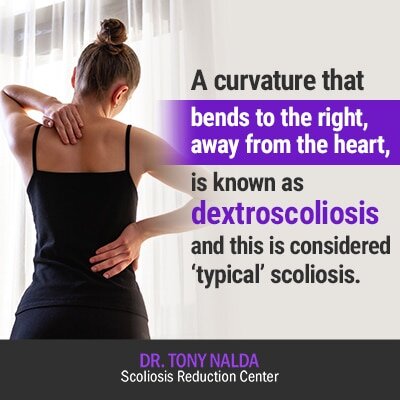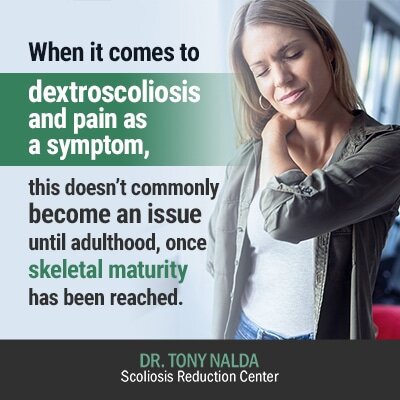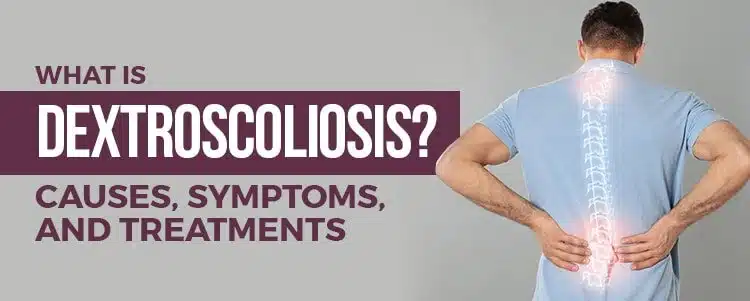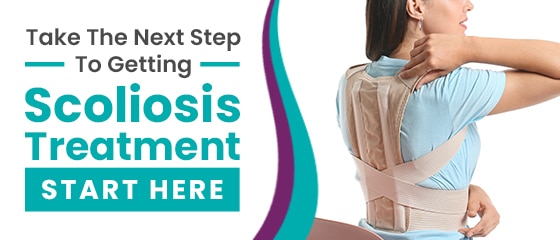Scoliosis is defined as an abnormal sideways spinal curvature that coincides with rotation. Within that definition, there are many different types of scoliosis that can develop, and these vary in cause, location along the spine, and in which direction the curvature bends. The term ‘dextroscoliosis’ specifies that the abnormal curvature bends to the right, which is a typical form of scoliosis with the curve bending away from the heart.
Scoliosis is not a simple condition. It’s not simple in terms of understanding causation as its most common form is classed as ‘idiopathic’, meaning no known single cause, and it’s not simple in terms of treatment. This is partially because of how much the condition varies case to case. Let’s start our exploration of dextroscoliosis by discussing the factors that can make one case differ widely from the next.
Classifying Scoliosis
When a condition is first diagnosed, part of that official diagnosis is to classify the condition by specifying its most important characteristics. When it comes to scoliosis, this process is especially important as successful treatment necessitates a customized approach.
Let’s also be clear that by ‘successful treatment’, I mean reducing the degree of curvature and working to sustain that reduction. As a progressive condition with no known cure, the treatment goal is to manage its progression and stay ahead of its nature to worsen over time.
Progression is the big factor in managing scoliosis. We can’t cure it, but we can treat it. While there’s no one-size-fits-all formula that can be applied to determine just how fast, or slowly, a condition is going to progress, there are variables that indicate likely rates of progression.
This leads us to the first big factor in classifying scoliosis: age of patient.
Age of Patient
The age of the patient doesn’t just give us an idea of their overall health and fitness level; it also tells us what likely rate of progression we are going to be dealing with.
As mentioned earlier, one of the biggest challenges with treating scoliosis is trying to stay ahead of a patient’s progression, and as that rate can vary greatly from patient to patient, this involves a lot of monitoring.
As we know that growth is the number one trigger for progression, we know that forms of scoliosis that affect younger people with lots of growth and development to go through are the likeliest to face rapid progression.
The condition’s most common form that makes up 80 percent of diagnosed cases is adolescent idiopathic scoliosis, diagnosed between the ages of 10 and 18.
In adults, we know that scoliosis progression tends to slow down as they’ve reached skeletal maturity and that big progression trigger has been removed.
When classifying the condition, the age of the patient tells us the likeliest rate of progression we’ll be monitoring for, and we frame our treatment approach accordingly.
The next big classification point is the type of scoliosis, meaning cause, if known.
Type of Scoliosis
We’ve talked about the condition’s most common form, adolescent idiopathic scoliosis, and we know this type of scoliosis has no known single cause; that’s the ‘idiopathic’ classification.
There are, however, other forms of the condition with known causes, although they only make up the remaining 20 percent of diagnosed cases: congenital, neuromuscular, degenerative, or traumatic.
In each of these forms with known causes, scoliosis develops as a secondary complication of a more serious medical issue, condition, or trauma.
If a case is classified as one of these types, we know that the underlying issue that has caused the scoliosis to develop has to be addressed, and these forms also have their own progression and treatment factors.
Another big classification point is condition severity, and this is determined by what’s known as the Cobb angle.
Condition Severity
Perhaps the most important classification point is condition severity. This is determined by measuring the patient’s Cobb angle via a scoliosis X-ray. This measurement helps us classify the condition as mild, moderate, or severe.
The measurement is taken from the most-tilted vertebrae at the apex of the curve, and it tells us just how far, in degrees, a patient’s spine deviates from a healthy alignment.
- Mild scoliosis: Cobb angle measurement of 25 degrees or less
- Moderate scoliosis: Cobb angle measurement between 25 and 40 degrees
- Severe scoliosis: Cobb angle measurement of 40+ degrees
The thing with scoliosis is that as a progressive condition, it’s virtually guaranteed to get worse. Once we classify the condition’s severity, we plan our treatment plan accordingly and design our approach.
Curvature Location
In addition to age of patient, type of curvature, and severity, where along the spine the scoliosis develops is also important.
The spine is divided into three main sections: cervical (upper spine and neck), thoracic (middle back), and lumbar (lower back).
Scoliosis that develops at different locations along the spine can produce different symptoms and indicate what a patient’s likely experience of living with their condition will be.
If scoliosis develops in the upper back, it’s classified as cervical. The thoracic spine is the most common site for scoliosis development, and scoliosis in the lower spine would be classified as lumbar scoliosis.
These designations tell us just where our treatment efforts need to be concentrated. Another important curvature characteristic takes us into defining dextroscoliosis.
What is Dextroscoliosis?

Now, we know scoliosis is an abnormal sideways curvature of the spine that measures at more than 10 degrees and coincides with rotation. We also know that the condition’s type and location along the spine is important. Another factor that informs our treatment approach is determined by which direction the curvature bends.
A curvature type that bends to the right, away from the heart, is known as dextroscoliosis, and this is considered ‘typical’ scoliosis. When a curvature bends to the left, towards the heart, this is known as levoscoliosis, is considered ‘atypical’, and warrants a different treatment approach.
Dextroscoliosis, characterized by a dextroconvexity in the spine, can manifest as various degrees of thoracolumbar dextroscoliosis, including minimal thoracic dextroscoliosis or even slight dextroscoliosis.
The causes and symptoms of dextroscoliotic curvature of the spine, whether in the context of neuromuscular scoliosis, degenerative scoliosis, adult scoliosis, or congenital scoliosis, vary and require tailored treatments to address the specific spine curves and alleviate associated discomfort.
When it comes to treating dextroscoliosis vs. levoscoliosis, the big difference is the red flag I see when I approach a case of levoscoliosis. As curvatures that bend to the left are atypical, I know that there is likely another pathology at work contributing to or causing the scoliosis.
I know that my first treatment step will be to address the presence of another pathology and treat it accordingly, and sometimes, this involves a referral to a specialist in the primary medical issue. Once that primary issue is diagnosed and assessed, we can then focus on how to move forward with treatment and how to address the scoliosis structurally.
So in terms of curvature location, if a patient’s condition is classified as ‘lumbar dextroscoliosis’, we know their curvature has developed in the lumbar spine and curves to the right; if a patient’s condition is classified as ‘thoracic dextroscoliosis’, we know their curvature has developed in their thoracic spine and curves to the right.
Dextroscoliosis refers to a type of spinal curvature where the spine rotates to the right, which is sometimes also called rotoscoliosis.
Also, a mild dextrocurvature of the lumbar spine’ denotes a subtle rightward bend in the lower back, similar to ‘dextroconvex curvature of the lumbar spine’. When we discuss what is dextroconvex scoliosis, we’re delving into a rightward convexity of the spine which can manifest in areas beyond the lumbar region, such as the dextroconvex curvature of the cervical spine that occurs in the neck.
Dextroscoliosis has various causes, symptoms, and treatments that differ from those of levoconvex scoliosis, which involves a leftward curvature.
Dextroscoliosis is a specific type of scoliosis characterized by a curvature of the spine that bends to the right. Understanding what the degrees of scoliosis mean is essential for assessing the severity of this condition and determining appropriate treatment options.
Treating Dextroscoliosis
Once a condition has been classified by comprehensively reading the patient’s scoliosis X-ray, I know everything I need to effectively treat the condition.
For example, if a patient has dextroscoliosis of the thoracic spine, I know that this is a typical case of scoliosis with no underlying pathology to address prior to initiating active treatment.
As mentioned, in typical scoliosis cases, such as adolescent idiopathic dextroscoliosis, there is no known single cause which is why it’s classed as ‘idiopathic’. We know that growth and development and how it exerts tension on the spinal cord plays a role in causation, but the general consensus is that idiopathic scoliosis is multifactorial, meaning caused by multiple factors that vary from patient to patient.
With this form and location, we know that a rib deformity, if not already present, is a likely symptom to appear with progression. Depending upon the patient’s age and Cobb angle, symptoms will vary.

Generally speaking, the more severe the condition is, the more noticeable symptoms it will produce. These would include changes to posture and gait. An overall asymmetry to the body is the main cosmetic change that people with scoliosis notice as shoulders appear uneven, a rib deformity can emerge, and clothing can hang unevenly.
When it comes to dextroscoliosis and pain as a symptom, this doesn’t commonly become an issue until adulthood, once skeletal maturity has been reached. With the condition’s most common form that develops in adolescence, growth is a constant factor, and that lengthening motion of the spine counteracts the compressive force of the curvature. When growth is no longer a factor, the spine and its surrounding nerves and muscles become vulnerable to compression.
Based on the classification points, we design our customized conservative treatment approach. Here at the Scoliosis Reduction Center®, our patients have access to multiple treatment disciplines in one convenient location. This is one of the reasons our treatment success rates are so high: because each and every patient gets a fully customized approach with the benefit of different forms of treatment.
Our main treatment tools include scoliosis-specific chiropractic, therapy, rehabilitation, and corrective bracing. Based on the condition’s characteristics and severity, we apportion each discipline accordingly. As we monitor progression, we tweak the plan and adjust the disciplines as needed in order to stay ahead of progression and achieve a curvature reduction.
Once we achieve a reduction and have addressed the structural issue of the deformity first and foremost, we work on maintaining those results and working with our patients to ensure they are sustainable.
Dextroscoliosis, a type of scoliosis, is characterized by a lateral curvature of the spine that bends towards the right. It’s essential to note that the diagnostic threshold for scoliosis is typically a curve of 10 degrees or more. While dextroscoliosis can manifest in various parts of the spine, thoracolumbar scoliosis specifically affects the area where the thoracic and lumbar regions meet.
The condition may result from different factors, including retrolisthesis and issues related to lumbar lordosis. Dextroscoliosis can lead to a range of symptoms, such as back pain and postural abnormalities, and in some cases, it may be associated with conditions like sciatica due to the compression of nerve roots. Treatment options for dextroscoliosis depend on its severity and the underlying causes, often involving physical therapy, bracing, or, in more extreme cases, surgical correction. Consulting with a healthcare professional is essential for a proper diagnosis and tailored treatment plan.
Dextroscoliosis of the Lumbar Spine
Scoliosis can develop in any of the spine’s main sections: the cervical spine (neck), thoracic spine (middle/upper back), and the lumbar spine (lower back).
Each of the spinal sections has its own unique role to play in maintaining spinal health, strength, and function, and the lumbar spine is often the most vulnerable to a number of spinal conditions/issues.
The lumbar vertebrae are often referred to as the stress vertebrae because not only do they have to support the weight of the spinal sections above, they also have to support the weight of the entire trunk, and also feel the effects of lifting, bending, and twisting motions.
It’s said that everyone will experience some degree of lower back pain at some point in their lives due to the importance of the lumbar spine and the strain it faces.
If a person develops dextroscoliosis of the lumbar spine, this means the unnatural scoliotic curve is bending to the right, away from the heart, and has developed in the last 5 vertebral bodies of the spine (L1 to L5).
Mild Dextroscoliosis of the Lumbar Spine Symptoms
When it comes to scoliosis symptoms, no two cases are the same, but in general, the area of the body located closest to the scoliotic spinal section is going to feel the majority of the condition’s direct effects.
When scoliosis is mild, its effects can still be subtle and difficult to detect.
In children, the main symptom of scoliosis is postural deviation that can include:
- Uneven shoulders
- Uneven shoulder blades
- The development of a rib arch
- Uneven hips
In adults, for whom the condition is compressive, the main symptom, even when mild, is pain, and that can include back pain and pain that radiates into the extremities due to nerve compression.
The important thing to understand about mild scoliosis is that as a progressive condition, it’s unlikely to stay that way, which is why being proactive with treatment is so important.
As scoliosis progresses from mild to moderate and severe to very severe, it’s getting increasingly severe as the size of the scoliotic curve increases, and the condition’s uneven forces are also increasing, as are their effects.
When scoliosis is mild, the unnatural spinal curve is small and simpler to treat, and the condition’s effects aren’t as established as they would be if they developed slowly over time, alongside progression.
There are never treatment guarantees, but when diagnosed and treated while still mild, there are fewer limits to what can be achieved.
When I diagnose mild dextroscoliosis of the lumbar spine, I want to start treatment as close to the time of diagnosis as possible as this is when treatment success is going to be the most likely as the spine will be at its most flexible and responsive to treatment.
Merely watching and waiting for signs of progression in mild cases is the common recommendation for those on the path of traditional scoliosis treatment, but modern conservative treatment sees waiting for a progressive condition to progress as wasting valuable treatment time.
What is Dextroconvex Scoliosis?
While there are different types of scoliotic curves and curvature patterns, every scoliotic curve has a concave and a convex portion; these are opposite sides of the unnatural spinal curve.
Scoliosis can involve the development of a single unnatural spinal curve, or a combined scoliosis that involves more than one spinal section, and in some cases, the spine responds to the loss of its healthy curves by putting in bad curves in an attempt to counteract the initial unnatural spinal curve’s uneven forces (compensatory curves).
The definition of concave is rounded inward or hollowed out, and conversely, convex means curved or rounded outward; the terms concave and convex have been around since ancient times but are often confused.
The truth is that most scoliotic spines have multiple unnatural curves so are going to have multiple concave and convex spinal portions throughout.
The concave side of a scoliotic curve is where the ribs are close together, and on the convex side, the ribs are separated by gaps, so the concave side of the scoliotic curve will round inward, and the convex side of the scoliotic curve rounds outward.
What is Dextroconvex Lumbar Scoliosis?
Dextroconvex scoliosis refers specifically to an S-shaped scoliotic curve that develops in the lumbar spine.
The lumbar spine is vulnerable to a number of spinal conditions/issues because of the unique roles it plays in how the spine functions; it has to support the weight of the trunk, the spinal sections above, and it feels the strain of bending, lifting, and twisting motions.
Mild Dextroconvex Lumbar Scoliosis
Mild dextroconvex scoliosis means the Cobb angle measurement falls within a range of 10 and 25 degrees, and when mild, lumbar scoliosis can be difficult to diagnose, particularly in children for whom the condition is not yet compressive.
In addition, mild scoliosis isn’t known to cause noticeable functional deficits: another challenge to early detection.
It’s compression of the spine and its surrounding muscles and nerves that causes the majority of condition-related pain.
Once skeletal maturity has been reached, the spine is no longer growing and experiencing the constant lengthening motion that counteracts the compressive force of the unnatural spinal curve.
For adults, the most common symptom of scoliosis is pain, and that includes back pain and pain that radiates into the extremities.
In many cases, scoliosis isn’t diagnosed while mild because often not until it progresses from mild to moderate that its symptoms tend to become noticeable.
Moderate Dextroconvex Lumbar Scoliosis
In cases of moderate dextroconvex lumbar scoliosis, the Cobb angle measurement falls within a range of 25 to 40 degrees, and its effects are mainly going to be felt in the lower back and body.
When the lumbar spine has developed an unnatural spinal curve, a common effect is sciatica.
As the sciatic nerve starts in the lumbar spine and extends down the back of the hip, buttock, leg, and into the foot, if the spine is unnaturally curved where the sciatic nerve is located within the spinal cord or where it exits the lumbar spine, it can experience compression, and that uneven pressure can irritate a nerve to the point that its neurological function is impaired.
Sciatic nerve pain can be felt anywhere along the pathway of the sciatic nerve, which extends throughout the lower body so can cause lower back, hip, leg, and foot pain.
As the sciatic nerve is a mixed nerve containing both motor and sensory fibers, if it’s exposed to uneven pressure, it can cause symptoms that affect both movement and sensation.
As a progressive condition, mild dextroconvex lumbar scoliosis is unlikely to remain mild, so where a scoliosis is at the time of diagnosis isn’t indicative of where it will stay; only proactive treatment can work towards counteracting the condition’s progressive nature.
Having scoliosis in the lumbar spine doesn’t guarantee sciatic nerve pain, but it is considered a common effect, and another effect of scoliosis is muscle pain, weakness, imbalance, and atrophy.
Concave versus Convex Curves and Muscle Strength
In most cases, it’s the muscles on the convex portions of a patient’s curve that are going to be stronger and more developed; these muscles are going to be longer as they have to hold the back in an upright position over time.
The muscles along the concave portion of a scoliotic curve are going to be shorter and more atrophied.
Scoliosis commonly causes the muscles on either side of the spine to become unbalanced; an unnaturally-curved spine pulls its surrounding muscles in different directions as they struggle to support and stabilize an atypical spine that tends to become increasingly misaligned over time.
The muscles on one side of the spine can become tight and sore from overuse, while muscles on the opposite side can become stretched and weak from underuse; part of scoliosis treatment focuses on rebuilding muscle strength and addressing any areas of weakness and unbalance.
As an asymmetrical condition, scoliosis introduces a lot of uneven forces to the spine, its surrounding muscles, nerves, and the entire body.
Scoliosis doesn’t just cause the visual change of uneven posture, it also disrupts the symmetry of the spine’s surrounding muscles; in addition, the condition’s uneven forces cause the body’s center of gravity to shift, and additional condition effects can include disruptions to balance, coordination, and gait.
It’s not just the spine that has to support its natural curves and alignment, but also its surrounding muscles that provide it with crucial support and stabilization, which is why increasing muscle strength is a focus of a conservative nonsurgical scoliosis treatment approach.
Conclusion
While exploring dextroscoliosis, its causes, symptoms, and treatments, it’s important to understand the degrees of curvature that categorize this spinal condition, why a 10-degree threshold is considered as the onset of scoliosis, and what do’s and don’ts apply for managing mild scoliosis.
When it comes to treating and understanding scoliosis, knowing the different forms the condition can take and how it’s classified tells us important characteristics.
Age of patient, type of curvature, location, and condition severity are factors that inform the roadmap for treatment. Here at the Scoliosis Reduction Center®, we customize each and every treatment plan to address the individual characteristics of the patient and their condition.
Dextroscoliosis means the abnormal spinal curvature bends to the right, which is a typical case as it bends away from the heart. This means we can initiate an active conservative treatment plan as close to the time of diagnosis as possible so as not to waste valuable treatment time.





